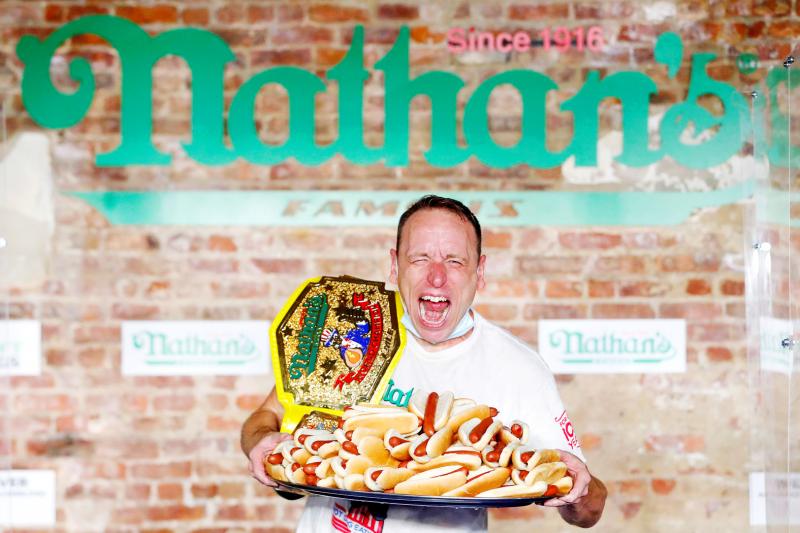The four-minute mile and the two-hour marathon were once believed impossible: now a new gauntlet has been thrown down for the world of elite competition. A scientific analysis suggests competitive eaters have come within nine hotdogs of the limits of human performance.
The theoretical ceiling has been set at 84 hotdogs in 10 minutes. The current world record, set by Joey “Jaws” Chestnut earlier this month, stands at 75.
James Smoliga, a sports medicine specialist at High Point University in North Carolina who authored the research, described 84 hotdogs as “the maximum possible limit for a Usain Bolt-type performance.”

Photo: REUTERS
The analysis is based on 39 years of historical data from Nathan’s Famous Hot Dog Eating Contest, an annual spectacle of gluttony held on Coney Island, New York, combined with the latest sports science theory, which uses mathematical modeling to project trends in performance.
Hotdog composition and size have, reportedly, remained unchanged at Nathan’s Famous in the fast food company’s 104-year history, allowing for valid comparison between competitors across years.
Improvement curves in elite sports ranging from sprinting to pole vaulting tend to follow a so-called sigmoidal curve, featuring an initial slow and steady rise, followed by an era of rapid improvement and finally a leveling off. “Hotdog eating has definitely reached that second plateau,” said Smoliga.

Photo: AP
The early years of the Nathan’s contest featured a motley assortment of winners — mostly “big obese guys” who chanced their luck on the day, according to Smoliga. In 1984, the contest was won by Birgit Felden, a 17-year-old, 130lb, West German judo team member, who managed nine-and-a-half hotdogs despite never having eaten one before the competition.
By the 1990s, the participation of Japanese extreme eaters changed the playing field. In 2001, Takeru Kobayashi downed 50 hotdogs, smashing the previous record of 25.125.
“It wasn’t just people with big appetites any more,” said Smoliga.
Elite eaters started to follow elaborate training regimes, with some ingesting vast volumes of liquid or gels to expand the stomach without having to process the calories.
Chestnut, this year’s winner, claims to train for three months leading up to the competition, including weekly practice runs, a carefully controlled diet and yoga and breathing exercises to help with mental focus.
In the trade, being lean is generally viewed as an advantage because a thick layer of fat round the middle can constrict the stomach.
The 84 theoretical maximum comes from fitting a curve to the data and also factoring in the possibility of outliers whose performance lies within a certain error margin of the curve.
The prediction should hold true, Smoliga said, unless a “new kind of competitor” shows up - someone with gigantism or a metabolic condition that placed them well outside the normal parameters of human biology.
The limiting factor is likely to be chewing and swallowing rather than gastric capacity, based on the observation that at the end of the 10 minutes many competitors are still trying to gobble down more sausages and buns.
According to the research, published in the Royal Society journal Biology Letters , the achievements of human speed eaters are impressive even by comparison with other species. “Humans are able to eat faster than bears or coyotes,” said Smoliga. Wolves, which devour prey at incredible speed, could outdo even elite human eaters, however.

Nov. 11 to Nov. 17 People may call Taipei a “living hell for pedestrians,” but back in the 1960s and 1970s, citizens were even discouraged from crossing major roads on foot. And there weren’t crosswalks or pedestrian signals at busy intersections. A 1978 editorial in the China Times (中國時報) reflected the government’s car-centric attitude: “Pedestrians too often risk their lives to compete with vehicles over road use instead of using an overpass. If they get hit by a car, who can they blame?” Taipei’s car traffic was growing exponentially during the 1960s, and along with it the frequency of accidents. The policy

Hourglass-shaped sex toys casually glide along a conveyor belt through an airy new store in Tokyo, the latest attempt by Japanese manufacturer Tenga to sell adult products without the shame that is often attached. At first glance it’s not even obvious that the sleek, colorful products on display are Japan’s favorite sex toys for men, but the store has drawn a stream of couples and tourists since opening this year. “Its openness surprised me,” said customer Masafumi Kawasaki, 45, “and made me a bit embarrassed that I’d had a ‘naughty’ image” of the company. I might have thought this was some kind

What first caught my eye when I entered the 921 Earthquake Museum was a yellow band running at an angle across the floor toward a pile of exposed soil. This marks the line where, in the early morning hours of Sept. 21, 1999, a massive magnitude 7.3 earthquake raised the earth over two meters along one side of the Chelungpu Fault (車籠埔斷層). The museum’s first gallery, named after this fault, takes visitors on a journey along its length, from the spot right in front of them, where the uplift is visible in the exposed soil, all the way to the farthest

The room glows vibrant pink, the floor flooded with hundreds of tiny pink marbles. As I approach the two chairs and a plush baroque sofa of matching fuchsia, what at first appears to be a scene of domestic bliss reveals itself to be anything but as gnarled metal nails and sharp spikes protrude from the cushions. An eerie cutout of a woman recoils into the armrest. This mixed-media installation captures generations of female anguish in Yun Suknam’s native South Korea, reflecting her observations and lived experience of the subjugated and serviceable housewife. The marbles are the mother’s sweat and tears,